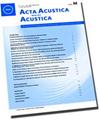音乐表演中音乐家动作的声学效果
Q1 Arts and Humanities
引用次数: 10
摘要
原声乐器作为动态声源,在一个专门的空间环境中向观众传达表演者的表达意图。从声学的角度来看,乐器的指向性不仅与听众中某一位置的乐器的响度和音色有关,还与所产生的声场的空间特征有关。然而,乐器是动态的声源,音乐家在舞台上的表演中总是会移动乐器。这项工作旨在评估这些运动的声学效果和感知相关性。为此,我们用光学运动跟踪系统记录了所有标准管弦乐乐器的独奏音乐表演,以及相应的音频信号。通过分析在消声和混响条件下的虚拟声环境中房间声学参数的频谱波动和时间依赖性来评估运动的影响。在随后的听力测试中,通过双耳合成向听众呈现了静态和动态音乐表演的听觉化,表明在消声和混响情况下都可以清楚地听到信号相关的波动。我们讨论了在虚拟声现实中如何考虑这些影响来模拟自然声源的不同方法。本文章由计算机程序翻译,如有差异,请以英文原文为准。
The Acoustical Effect of Musicians' Movements During Musical Performances
Acoustic musical instruments act as dynamic sound sources communicating the expressive intentions of a performer to the audience in a dedicated spatial environment. From an acoustical point of view, the directivity of musical instruments is relevant both for the loudness and timbre of an instrument at a certain position in the loudness and timbre of an instrument at a certain position in the audience, as well as for the spatial characteristics of the generated sound field. Musical instruments, however, are dynamic sound sources always moved by musicians as an element of their performance on stage. This work aims at assessing the acoustical effect and the perceptual relevance of these movements. For this purpose, we have recorded solo musical performances with all standard orchestral instruments with an optical motion tracking system, as well as the corresponding audio signals. The effect of the movements was evaluated by analysing the spectral fluctuation and the time-dependence of room acoustical parameters in a virtual acoustic environment in anechoic and reverberant conditions. In a subsequent listening test, an auralization of the static and dynamic musical performance was presented to listeners by binaural synthesis, showing that the signal-related fluctuations are clearly audible both in anechoic and reverberant situations. We discuss different approaches how to consider these effects for the simulation of natural acoustic sources in virtual acoustic reality.
求助全文
通过发布文献求助,成功后即可免费获取论文全文。
去求助
来源期刊
CiteScore
2.60
自引率
0.00%
发文量
0
审稿时长
6.8 months
期刊介绍:
Cessation. Acta Acustica united with Acustica (Acta Acust united Ac), was published together with the European Acoustics Association (EAA). It was an international, peer-reviewed journal on acoustics. It published original articles on all subjects in the field of acoustics, such as
• General Linear Acoustics, • Nonlinear Acoustics, Macrosonics, • Aeroacoustics, • Atmospheric Sound, • Underwater Sound, • Ultrasonics, • Physical Acoustics, • Structural Acoustics, • Noise Control, • Active Control, • Environmental Noise, • Building Acoustics, • Room Acoustics, • Acoustic Materials and Metamaterials, • Audio Signal Processing and Transducers, • Computational and Numerical Acoustics, • Hearing, Audiology and Psychoacoustics, • Speech,
• Musical Acoustics, • Virtual Acoustics, • Auditory Quality of Systems, • Animal Bioacoustics, • History of Acoustics.

 求助内容:
求助内容: 应助结果提醒方式:
应助结果提醒方式:


